IRV BROWN EXHIBITION, TUCSON GEM & MINERAL SHOW 2017
Below are examples of investment quality mineral species.
This stunning Calcite specimen is from a locality that has literally provided thousands of calcites over the years. This mine is so large that the miners can drive a Jeep for over thirty miles underground!
Why is this specimen investment quality? The “butterfly” twin calcite crystal is jewel-like in its quality. The exceptional clarity, glowing amber color, and glass-like luster make this calcite stand heads and shoulders above the rest. The aesthetics of this specimen with the gem calcite crystal perched on snow white dolomite in association with the lustrous black sphalerite make this piece an artistic tour-de-force.
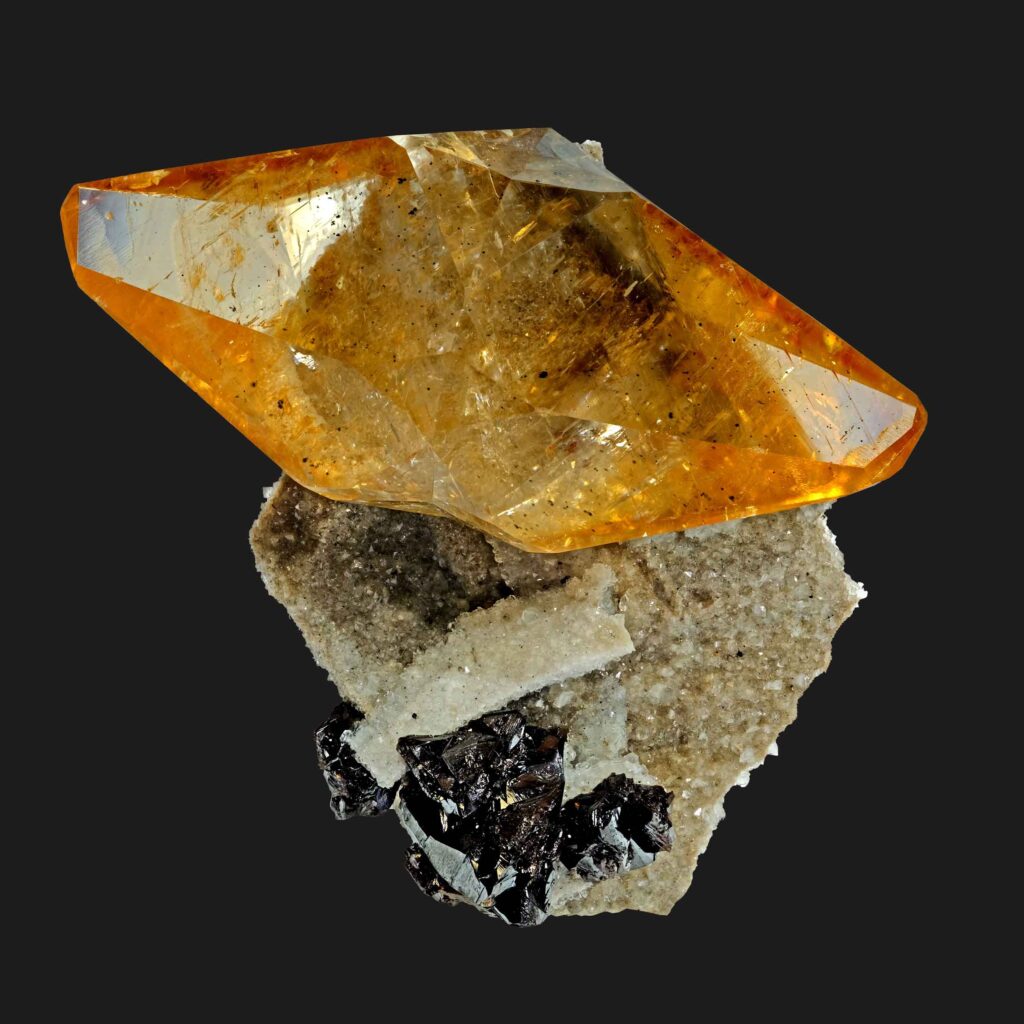
What makes this specimen investment grade:
● “Wow factor” specimen.
● Perfect condition and superb aesthetics.
● Exceptional clarity, color, and luster.
● Singular example from a prolific locality.
Representative localities:
● Deccan Plateau, India
● Hunan Province, China
● Cumbria, United Kingdom
● Numerous localities in Africa
The Minerva mine is a quintessential American mineral locality that more than holds its own against any Fluorite locality in the world. This particular example is from the 1990 “blue-cap” pocket, widely considered the finest Fluorite pocket from the Southern Illinois Fluorspar District. The provenance of this specimen is as good as it gets; the uber-important Ross Lilly Southern Illinois mineral collection; the finest such collection ever assembled.
This specimen has several exceptional qualities that make it a perfect candidate for investment. Vibrant color zoning, along with superb condition and transparency coupled with ethereal aesthetics reminiscent of a supernova. Fluorite is literally like holding a rainbow in your hand…
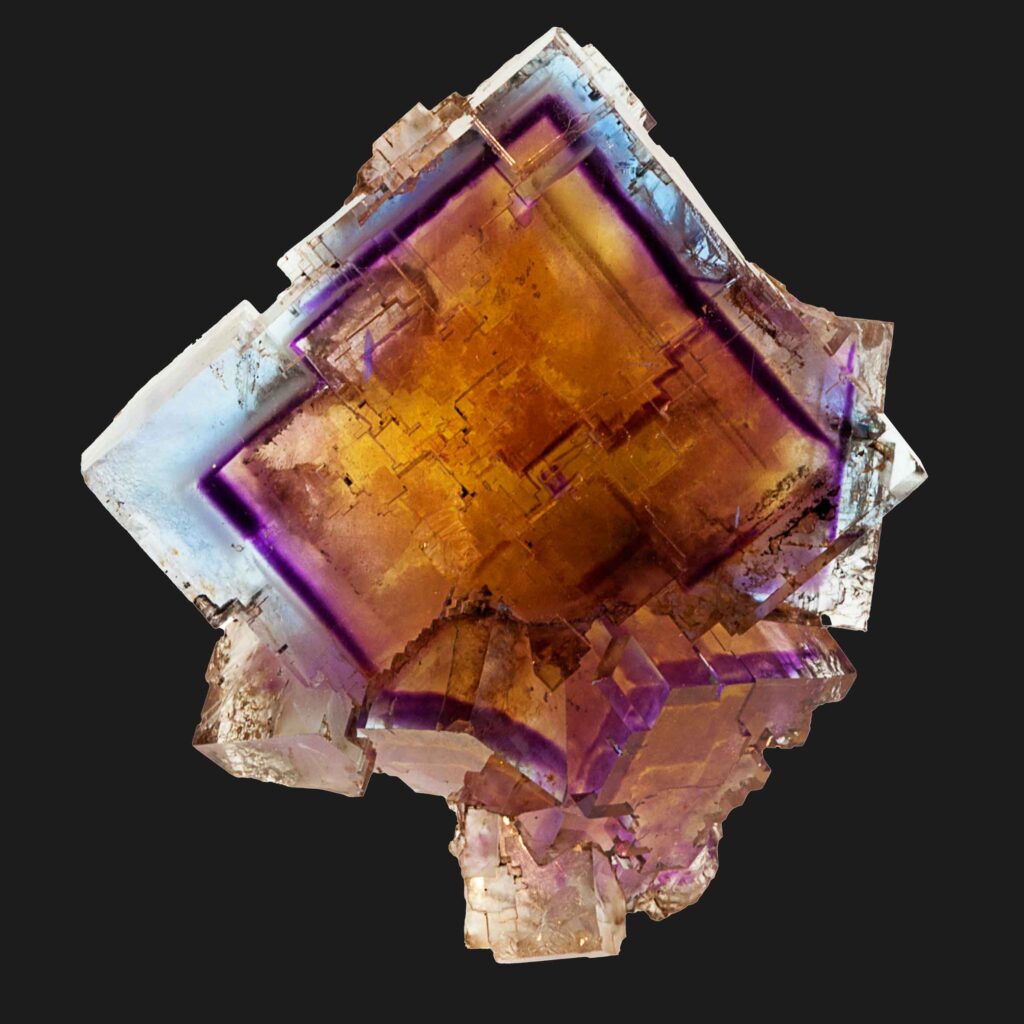
What makes this specimen investment grade:
● Vibrant color-zoning and glass luster
● Pristine condition and aesthetic composition
● 1990 ”blue-cap” pocket (best find from Minerva 1)
● A prime example from the famous Ross Lilly mineral collection
Representative localities:
● Chamonix, France
● Weardale, England
● Hunan Province, China
● Dalnegorsk, Russia
● Okorusu, Namibia
This is the mineral that started it all… How many of you carried a Quartz crystal in your pocket when you were young? When gazing upon a pristine, insanely sharp multifaceted Quartz crystal, thoughts of Superman’s cave come to mind. Quartz is one of the most common minerals on the planet, yet select individual specimens are worthy of an investment portfolio.
The example shown here is from the famous McEarl mine in Arkansas, considered one of the finest quartz mines in the world. Upon setting your eyes on a great McEarl Quartz specimen, a surreal countenance overpowers your soul. The sheer perfection of the natural assemblage defies the imagination. Simply, this natural wonder does not look real…
Amethyst is, of course, the purple variety of Quartz, whilst the clear brown version is Smoky Quartz. Subtle variables in color saturation and crystallography can make significant differences in specimen valuation. (Considerations such as aesthetics, matrix, and twinning add to the uniqueness necessary for a high investment valuation.)
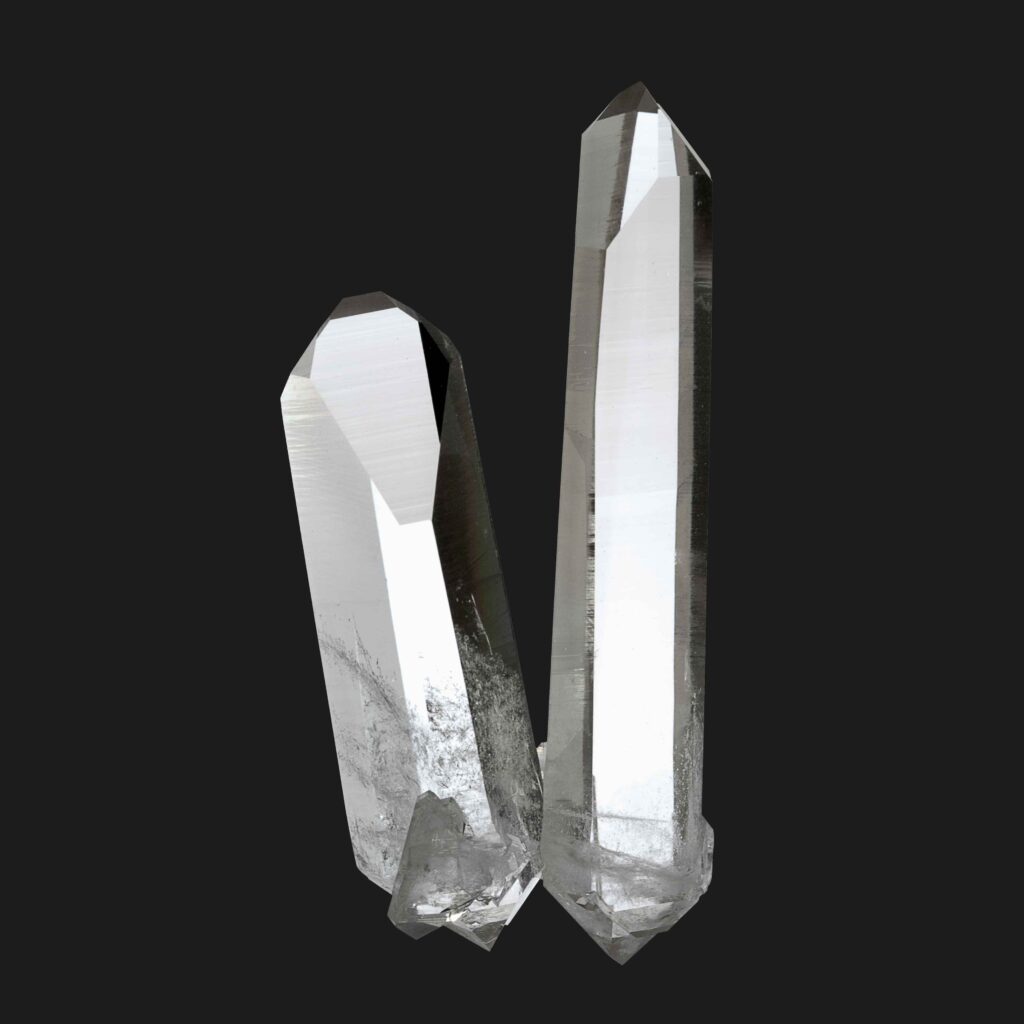
What makes this specimen investment grade:
● ”Wow factor” – Specimen looks manufactured
● Crystal form and aesthetics, crystals are doubly terminated
(extremely rare for the locality)
● Condition, sharpness, and clarity
● Color saturation (Amethyst and Smoky Quartz)
Representative localities:
● Bourg D’Oisans, France
● Minas Gerais, Brazil
● Santander, Colombia
● Veracruz, Mexico
(Amethyst)
● Cavradi Gorge, Switzerland
(Smoky Quartz Gwindels)
Silver from Kongsberg, Norway… the Holy Grail of classic minerals. One of the great attributes of Kongsberg silver is the sheer variety of appealing forms. Artists and poets would gravitate to this example which is reminiscent of a ghost from a Dickens novel. You can almost imagine the free-flowing gown of the Dickinsonian heroine or a medieval dragon waiting to be slain by a knight. Wire silver, in nature, is quite rare, whilst crystallized silver is almost unheard of. Both varieties are found in the Kongsberg mining district.
Most mined silver is smelted from ore therefore, wire and crystallized specimens are highly desirable. An active mine does not have the manpower nor the time to collect specimens. This aspect of commercial mining minimizes the amount of collectible specimens that reach the marketplace.
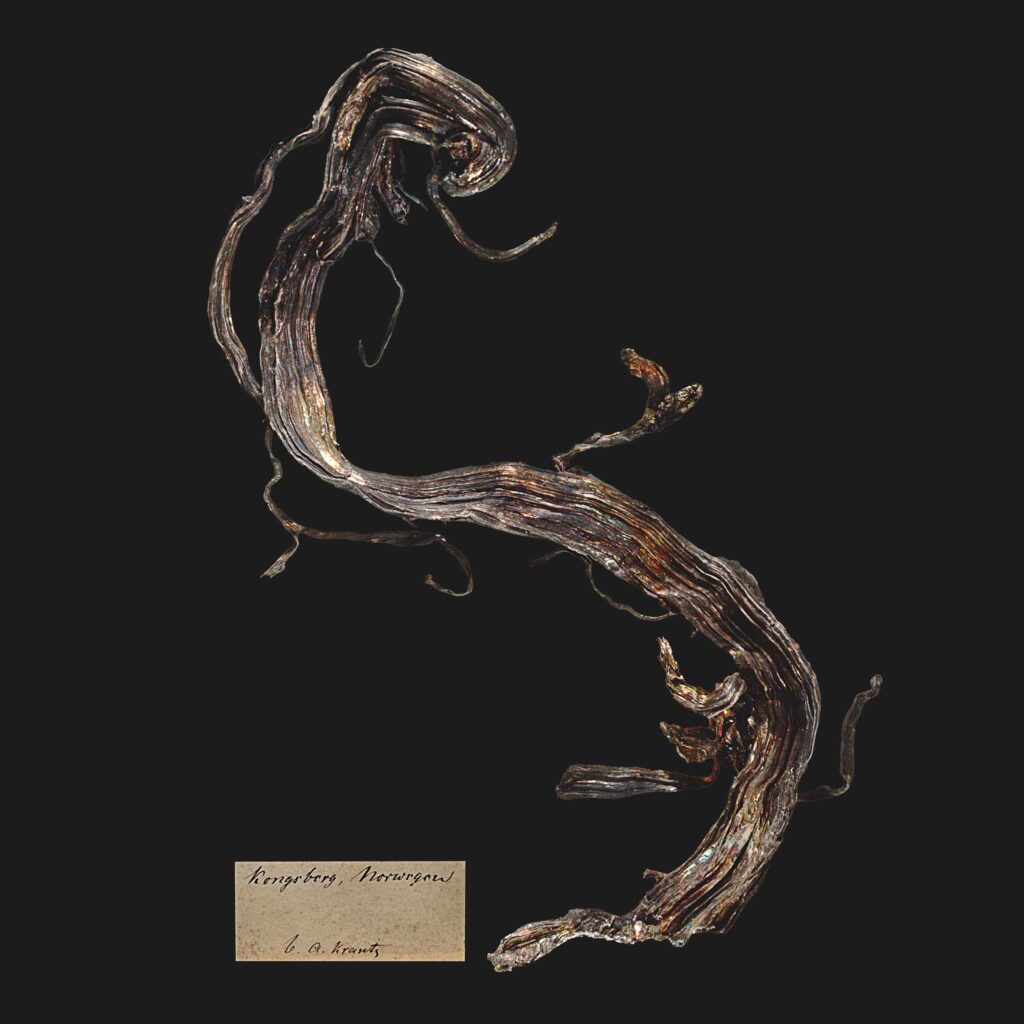
What makes this specimen investment grade:
● Aesthetics that mimic fine art
● Excellent patina
● Classic locality (closed)
● Superb provenance – Krantz Collection
Representative localities:
● Freiburg, Germany
● Houghton County, Michigan
● Batopilas, Mexico
● Chanarcillo, Chile
This native copper icon would feel at home in the Metropolitan Museum of Art in New York City… The form, luster, and sharpness of the crystals are absolutely superb, but those stellar attributes pale in comparison to the overall visual impact this specimen elicits from the casual observer. Nature has created a Rodin that predates the sculptor by millions of years. The warm chocolately brown patina and the three-dimensional geometric quality of the crystals, in combination with the overall pristine condition, solidify the world-class status of this iconic mineral specimen.
A select few mineral specimens transcend science and directly appeal to the artist within us. Rodin might have been jealous…
In general, the connoisseurship necessary to evaluate and appreciate native metals makes investing in copper specimens both experiential and knowledge-intensive. In other words, view as many specimens as you can. All major museums have native copper specimens on display, but the quintessential institution to see native copper and silver specimens is Michigan Tech. University in Houghton.
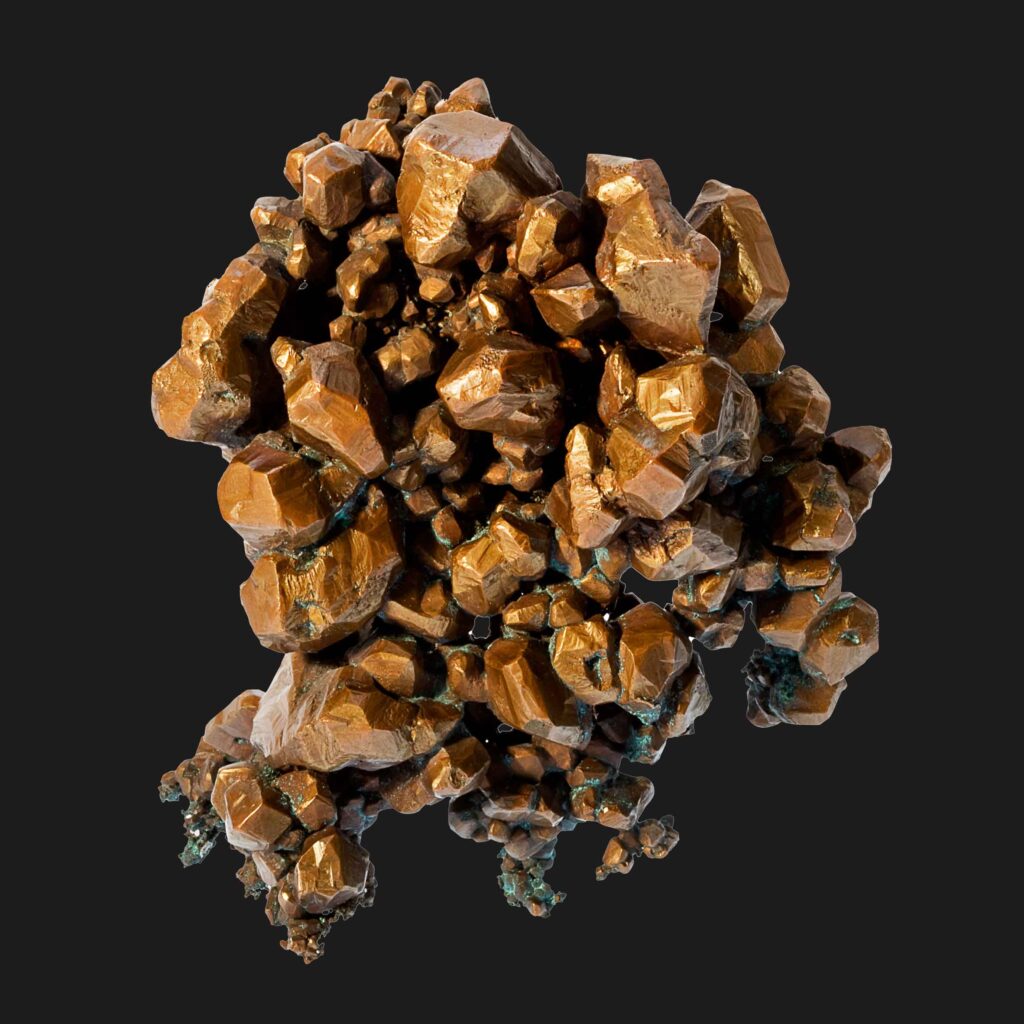
What makes this specimen investment grade:
● “Wow factor” – form and quality of a Rodin sculpture
● Magnificent chocolate brown patina
● Sharp three-dimensional geometric crystals
● Pristine work of nature
● ”Rockstar” – published in various media locations
(cover of Mineralogical Record)
● Example is an ”11” !
● Superb provenance dating back to the 19th century.
Representative localities:
● Ajo, Arizona
● Onganja Mine, Namibia
● Broken Hill, Australia
● Itauz, Kazakhstan
COLOR, COLOR, COLOR. Tourmaline is a mineral that can be a fruit salad, a rainbow, or paint swatches from a hardware store. Each time you gaze into your mineral cabinet, the colors will enthrall you. Tourmaline is a highly sought-after collectible for this very reason. The sheer beauty, coupled with the inherent gem value of this species, makes for an excellent potential investment.
This rock elicits an ethereal response from non-mineral cognoscenti. In other words, people freak out when they see it.
The artistic and aesthetic aspects of this natural “eye-candy”, again transcend science. The vivid blue and green colors, the luster, and the transparency coupled with the contrasting opaque quartz matrix make for a stunning visual feast reminiscent of the northern lights.
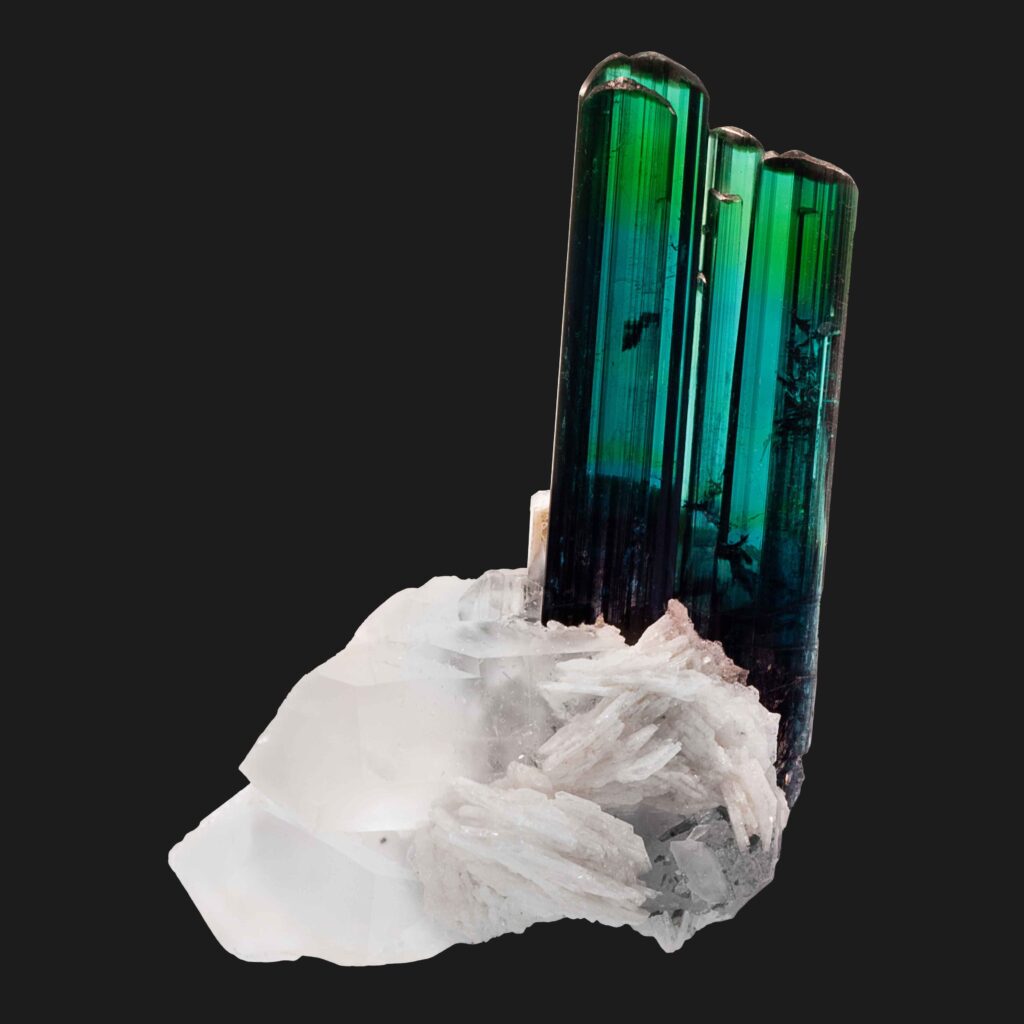
What makes this specimen investment grade:
● “Eye-candy” – intense, highly saturated color
(green and blue are side by side in the color spectrum)
● Gem crystals contrast favorably with quartz matrix
● “Rockstar” – published in numerous media sources
● Example is an ”11” !
● Beauty appeals to the general public
Representative localities:
● Minas Gerais, Brazil
● Pakistan/Afghanistan
● San Diego County, California
● Elba, Italy
Like Excalibur coming out of the stone, the lavender pink topaz crystal contrasts uniquely with the feldspar and quartz matrix. Topaz is a fairly common gem mineral. Pink topaz is not. Although repaired, the extreme rarity of this piece makes for a highly desirable and coveted mineral specimen. Hot pink topaz, found in Russia and Pakistan, has only been discovered in very limited quantities. When considering a high-quality investment-grade mineral specimen, the buyer should keep in mind limited quantities, beauty, and desirability. This particular example checks all the boxes.
Gem topaz comes in numerous colors, including champagne browns, imperial orange/pink, and sky blue. In extremely rare instances, topaz can be red. The champagne browns tend not to be color stable and can fade with exposure to light. The most valuable gem variety of topaz is called imperial, which can mimic fine padparadscha sapphire orange with pink highlights.
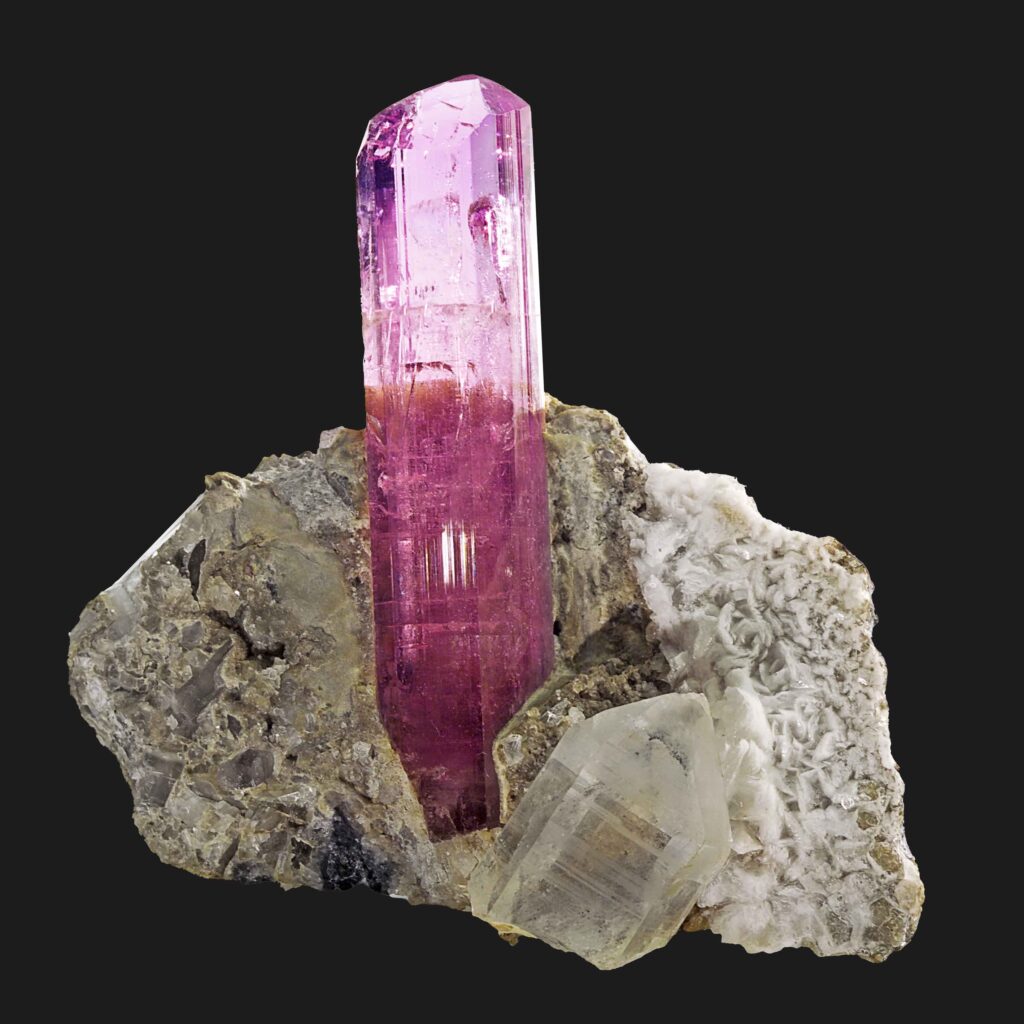
What makes this specimen investment grade:
● Vibrant hot pink color
● Excellent aesthetics
(Topaz crystal juxtaposed with clear quartz crystal)
● Extreme rarity – limited localities
● ”Rockstar” – published in numerous media sources
Representative localities:
● Minas Gerais, Brazil
(Sky blue/imperial topaz)
● Katlang, Pakistan
(Champagne/pink)
● Ramona, California
(Sky blue)
● Myanmar
(Champagne)
Def. perfection, noun, per·fec·tion: “Perfection is a flawless state where everything is exactly right.”
In the mineral world, rarely do we use the word “perfection,” let alone “flawless”. This specimen has flawless perfection in three key areas: natural crystal faces that present like a faceted jewel, transparency that you can literally read through, and superb blue color reminiscent of the finest sky. The coup de grâce for this natural work of art is the silvery white muscovite matrix the jewel crystal resides upon. In the literary work “Masterpieces of the Mineral World”, Joel A. Bartsch uses this specimen to epitomize perfection in a mineral specimen. To add even more desirability, the specimen was in the James Horner mineral collection, which resided in the Houston Museum of Natural Science. Dusso, Pakistan has produced thousands of aquamarines, and this one stands significantly above the rest. Perfection indeed…
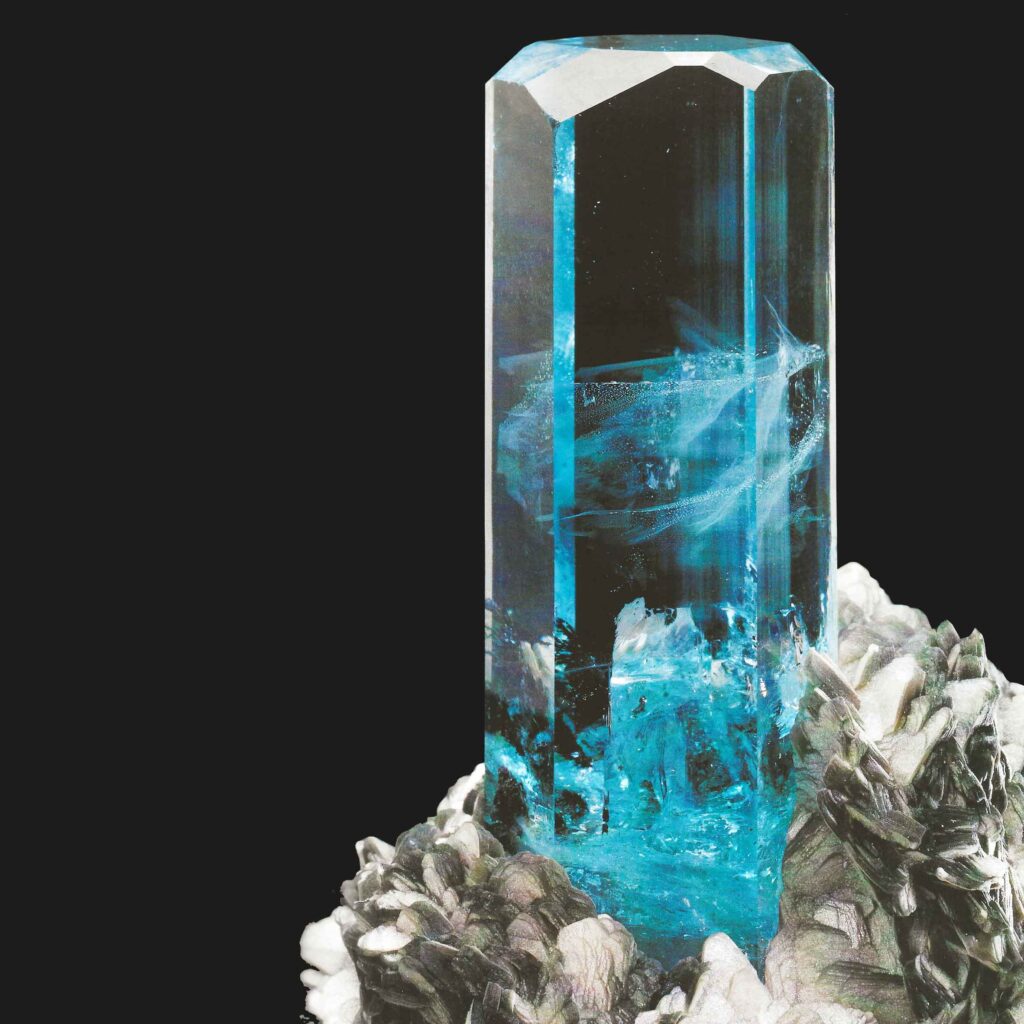
What makes this specimen investment grade:
● Insane condition (perfection)
● Vibrant sky-blue color
● Highly aesthetic – faceted aquamarine prism on silvery white matrix
● “Rockstar” – published in numerous media sources
● Example is an ”11” !
● Superb provenance – ex-James Horner
(composer – Titanic soundtrack)
Representative localities:
● Minas Gerais, Brazil
● Afghanistan, Pakistan – pegmatites
● Ural Mountains, Russia
● Erongo, Namibia
“Three-Amigos”. You know a mineral specimen is truly special when it has been named by the public. Nature decided to place three of the finest quality emerald crystals reminiscent of faceted gems upon a non-descript black calcite matrix. Thus, this incredible specimen was christened “Three-Amigos” by the Gemological Institute of America in Carlsbad, California.
Mother nature outdid herself in the creation of this natural wonder… The vivid green crystals have an inner life that is hard to convey through photographs. “Three-Amigos” has been universally acclaimed as the finest quality matrix emerald in existence. Gem, green, and gorgeous are the attributes that make this specimen so otherwordly.
I’ve had many transcendent experiences in my mineral and gem career and the first time laying eyes on this incredible specimen is clearly at the top. When “Three-Amigos” was first displayed at the Tucson Gem and Mineral Show, Ron Ringsrud, emerald expert, posted on Instagram: “Who is Irv Brown, and how did he find such a perfect emerald?”.
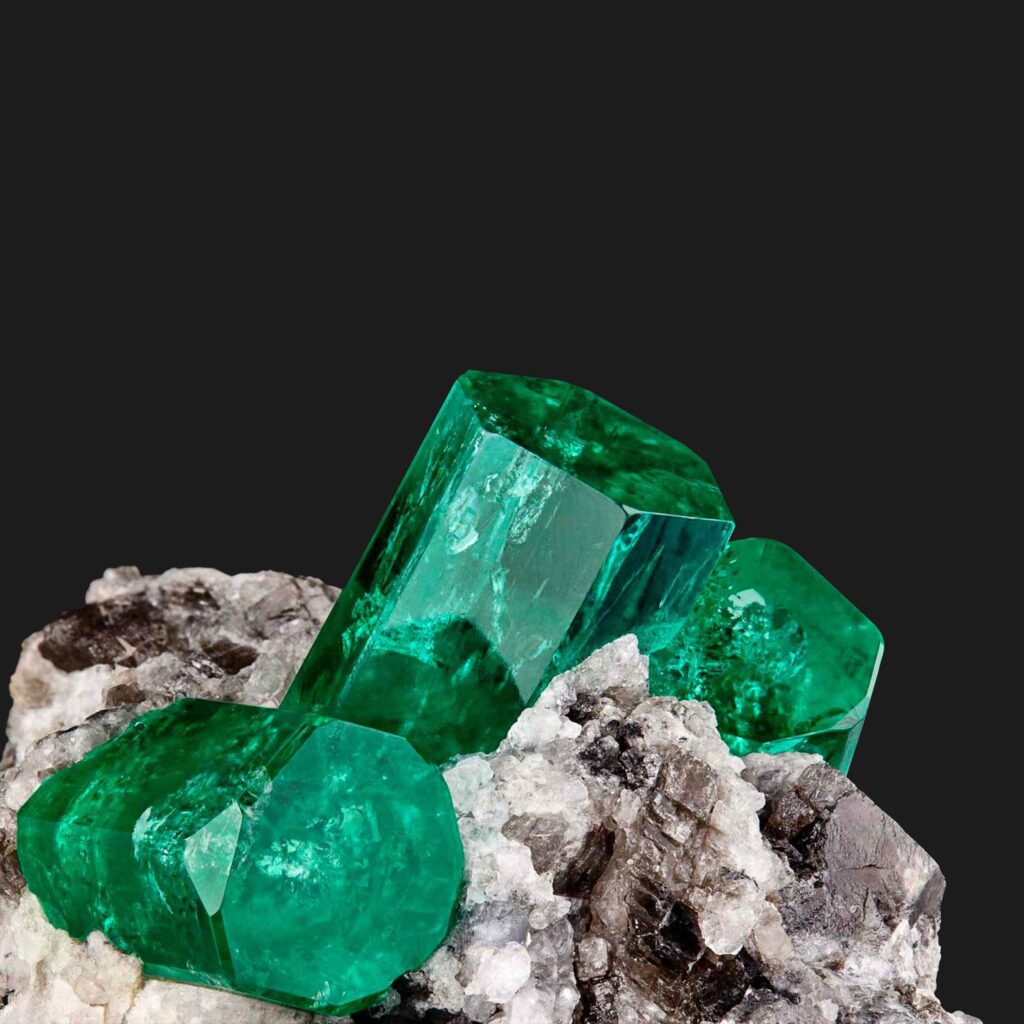
What makes this specimen investment grade:
● Unparalleled condition
● Vivid emerald color of the finest quality
● Sharp unetched crystals on non-descript black calcite matrix
(great textural and color contrast)
● Example is an ”11” !
● Exhibited at GIA Carlsbad, Tucson Gem, and Mineral Show, Wilensky Emerald Exhibition.
● Award winner Lidstrum Trophy 2019
Representative localities:
● Muzo, Colombia
● North Carolina, USA
● Kafubu Area, Zambia
● Cleopatra’s emerald mine, Egypt
Lead never looked so good… In one of nature’s enigmas, dull, boring lead turns into lustrous bright orange wulfenite crystals with some geologic help. Ugly duckling turning into a beautiful swan…
This example found at the Red Cloud Mine in 1996 is aesthetically superior, with the large main crystal isolated perfectly in the center of the matrix. The large bright-orange center wulfenite blade surrounded by smaller gem crystals, coupled with the contrasting black matrix, really makes the specimen pop. The vivid color, luster, and form are reminiscent of the most beautiful summer sunset.
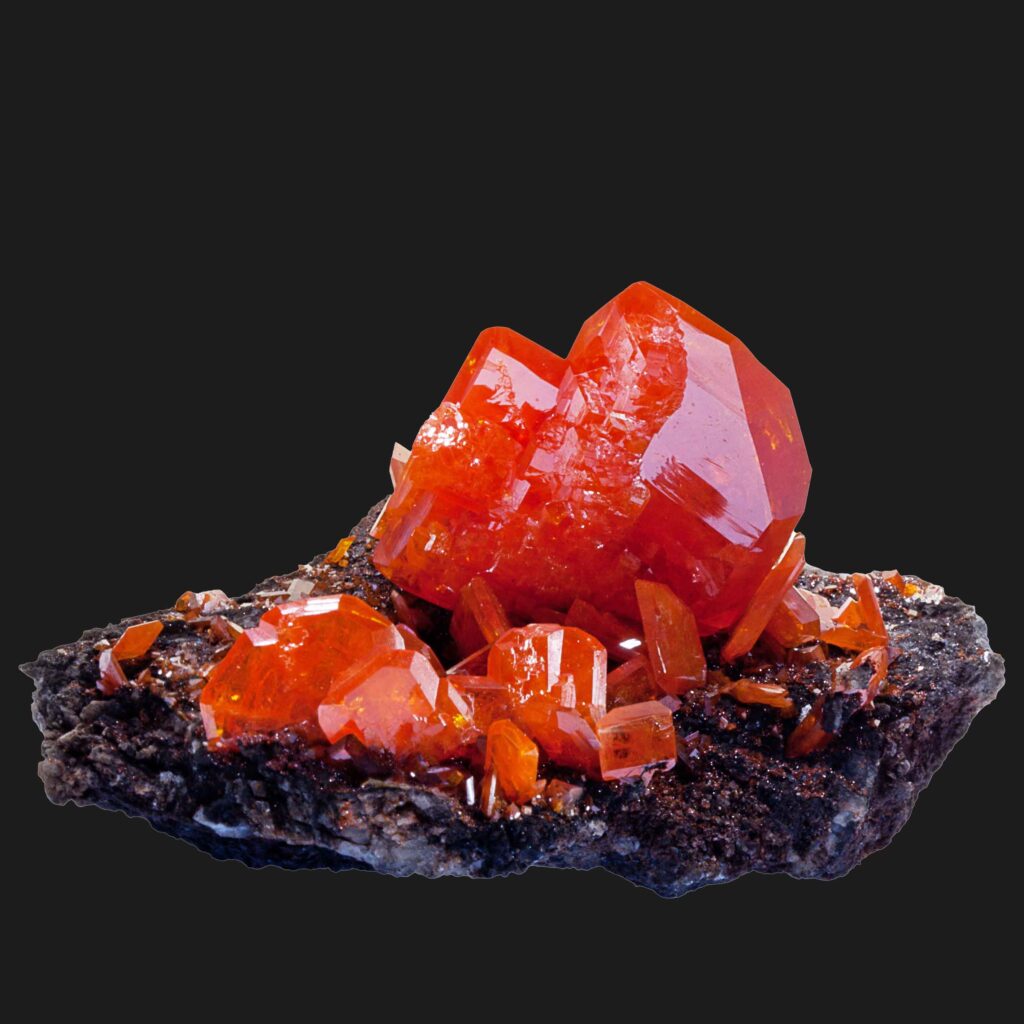
What makes this specimen investment grade:
● Isolated bright orange crystal centered on the matrix
● Classic wulfenite locality
● Superb luster and condition
Representative localities:
● Tsumeb, Namibia
● San Francisco Mine, Mexico
● Rowley Mine, Arizona
● Mibladen, Morocco
Did Midas really have the golden touch? Clearly, he would’ve loved this gold… Highly lustrous spinel twinned crystals up to two centimeters highlight this important and beautiful matrix gold specimen. One side of the piece shows flattened crystals with mirror luster, while the opposite side shows well-defined octahedral gold crystals perched on skeletal complex crystals.
The two opposite views of the same specimen are reminiscent of Castor and Pollux of greek-roman mythology. To complete this naturally artistic tour-de-force is the white quartz matrix the rich yellow gold is balanced upon.
Many of these gold specimens are etched out of the quartz matrix with acid. This specimen is what is called a “pocket gold” that grew unimpeded into the pocket void. Gold specimens such as this are valued hundreds of times their intrinsic gold value, hence a great investment.
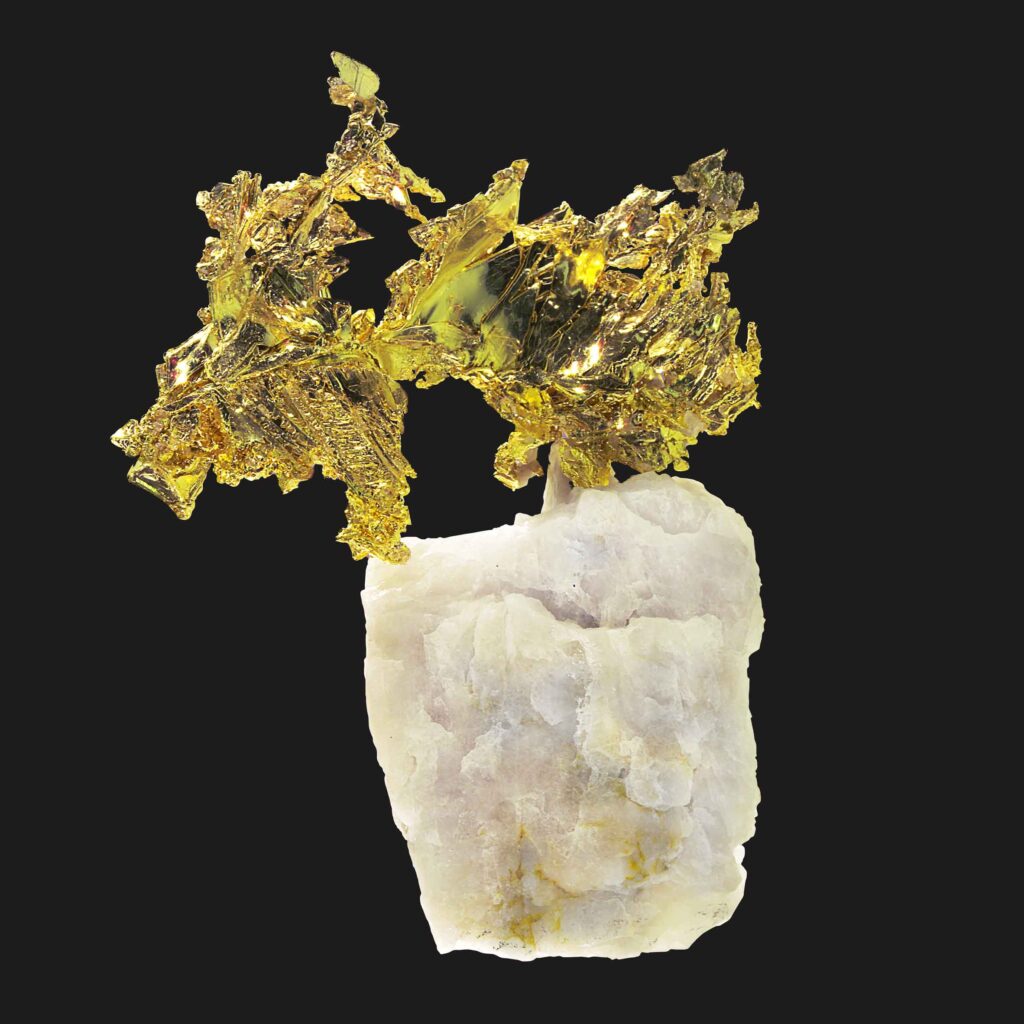
What makes this specimen investment grade:
● Multiple crystal habits
● Highly lustrous buttery-yellow color
● Large crystal size
● Sculptural aesthetics with contrasting matrix
● Excellent provenance – J. Horner collection
Representative localities:
● California Gold Country, USA
● Verespatek, Romania
● Venezuela gold fields
Rhodon, greek; ”rose” + Chroma, greek; ”color” = Rhodochrosite
The color red evokes energy. Prepare to hyperventilate… A great rhodochrosite might just take your breath away! A single sharp gem rhodochrosite crystal perched on lustrous black tetrahedrite so unimaginable, so surreal, that seasoned collectors are at a loss for words. Nature simply doesn’t do this very often… Arguably the finest rhodochrosites are mined from the Sweet Home Mine in Alma, Colorado, and this spectacular specimen is from the famous “Good-Luck” pocket. In terms of gemminess, crystal form, color, and clarity, this pocket is considered the finest the mine has ever produced.
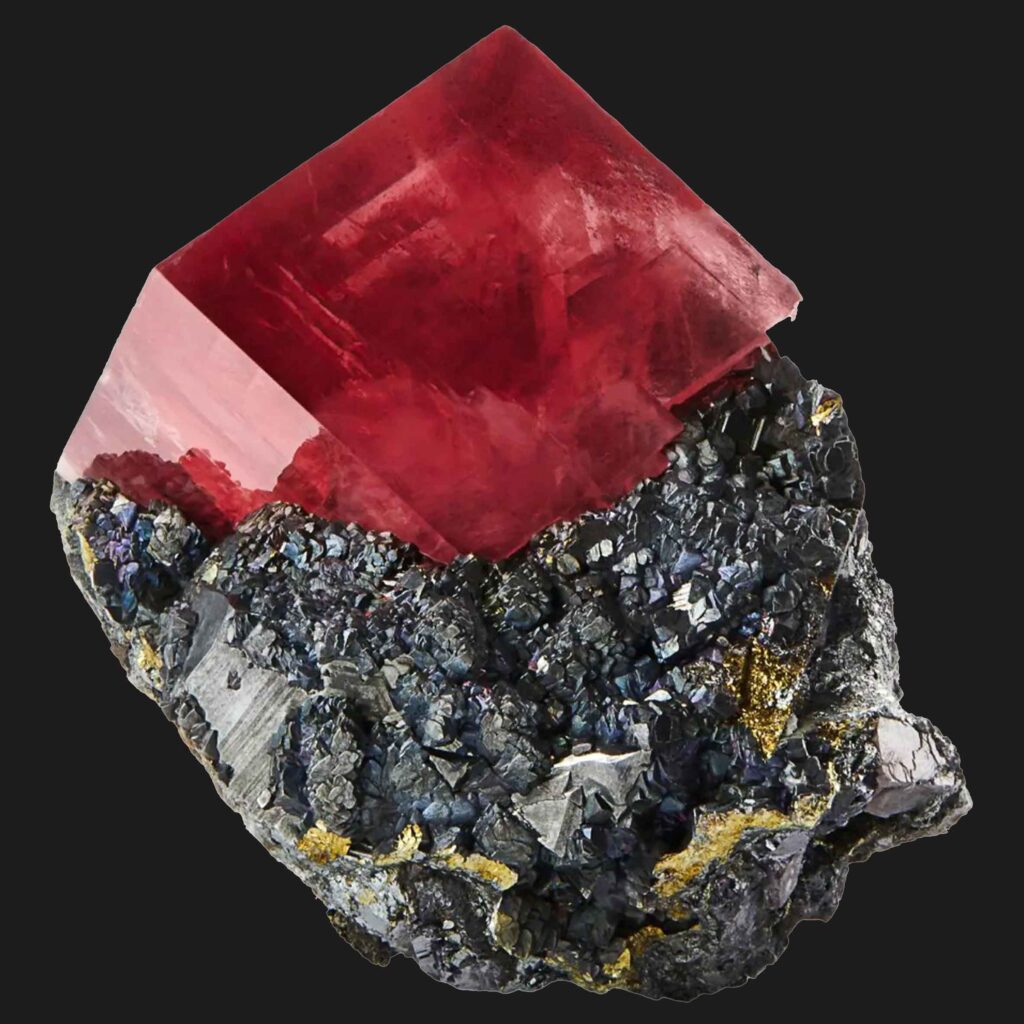
What makes this specimen investment grade:
● ”Wow factor” – jewel-like
● Contrasting red crystal on lustrous black matrix
● Flawless gem crystal
● Classic locality
Representative localities:
● N’Chwaning II Mine, South Africa
● Capillitas Mine, Argentina
● Wutong Mine, China
● Santa Eulalia, Mexico
The meeting of earth and sky… The glassy azure blue of the azurite perched upon the rolling hills of matte green malachite make this example a spiritual and visual feast. The association of azurite with malachite is one of the most beautiful color combinations in the entire mineral kingdom, as evidenced by the use of azurite and malachite as paint pigments over the millennia. This specimen reminiscent of a bird’s nest is Chinese in origin, Liu Feng Shan Mine, and would have a spiritual connection to east-Asian culture. This particular mineral specimen would greatly appeal to the burgeoning Chinese mineral market, thus an excellent investment quality choice.
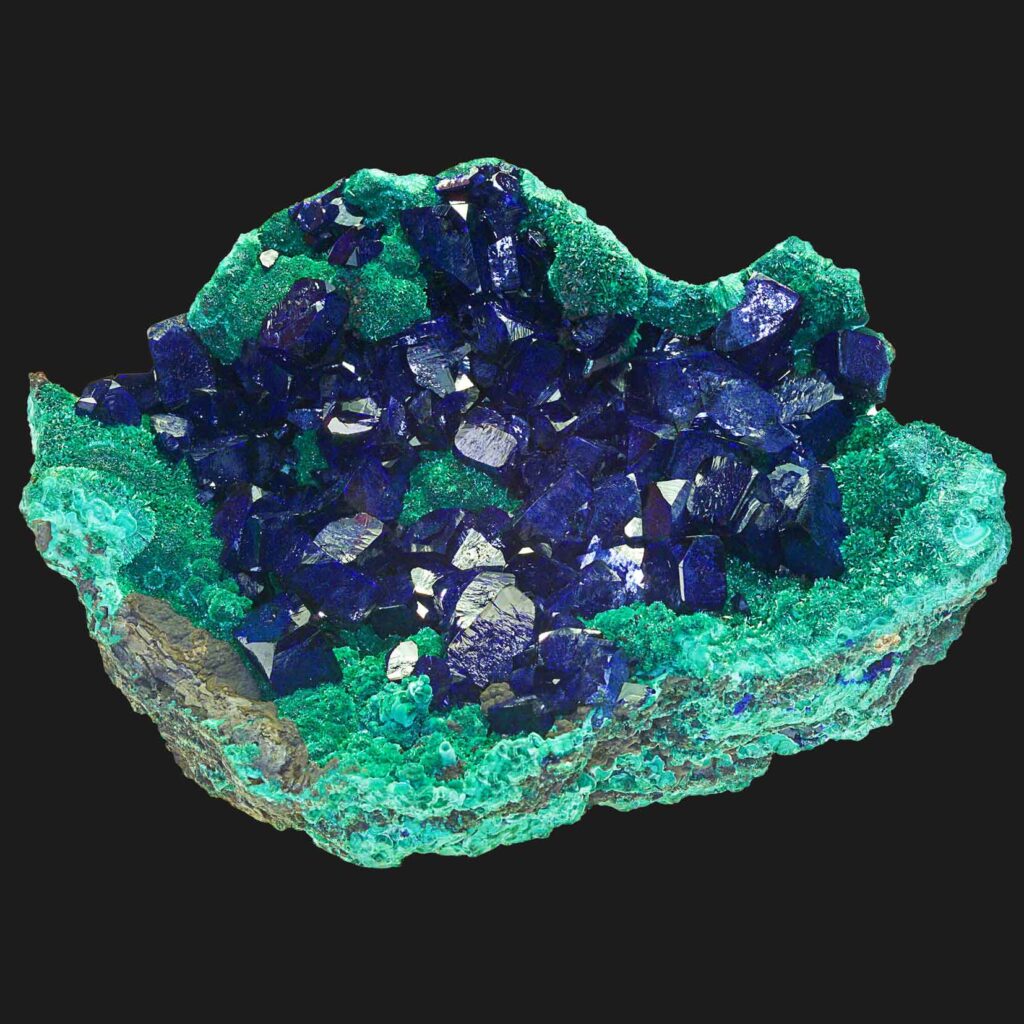
What makes this specimen investment grade:
● Unique aesthetic form
(birds-nest)
● Vivid color contrast – lustrous blue contrasting with matte green
(green and blue are side by side on the color spectrum)
● Pristine condition
● Rare locality
Representative localities:
● Tsumeb, Namibia
● Bisbee, Arizona
● Touissit, Morocco
● Milpillas, Mexico
”Fools gold”. Only a fool would pass on owning this pyrite. Yes, pyrite has a reputation for being inexpensive and common, not this specimen. Intense golden luster, striated crystals with micro-facets, and absolutely flawless condition make for an awe-inspiring mineral specimen. Literally, there are thousands of pyrite specimens, and this is arguably the best example.
Architecturally the aesthetics of this pyrite bring to mind a Mayan temple sitting atop a mountain surrounded by a dense rainforest. Pyrite is so prevalent in the marketplace that it is possible to acquire a world-class example at a reasonable price point, thus an excellent potential investment. I advise viewing as many pyrite specimens as possible and selecting an example that brings to mind this specimen. Happy hunting…
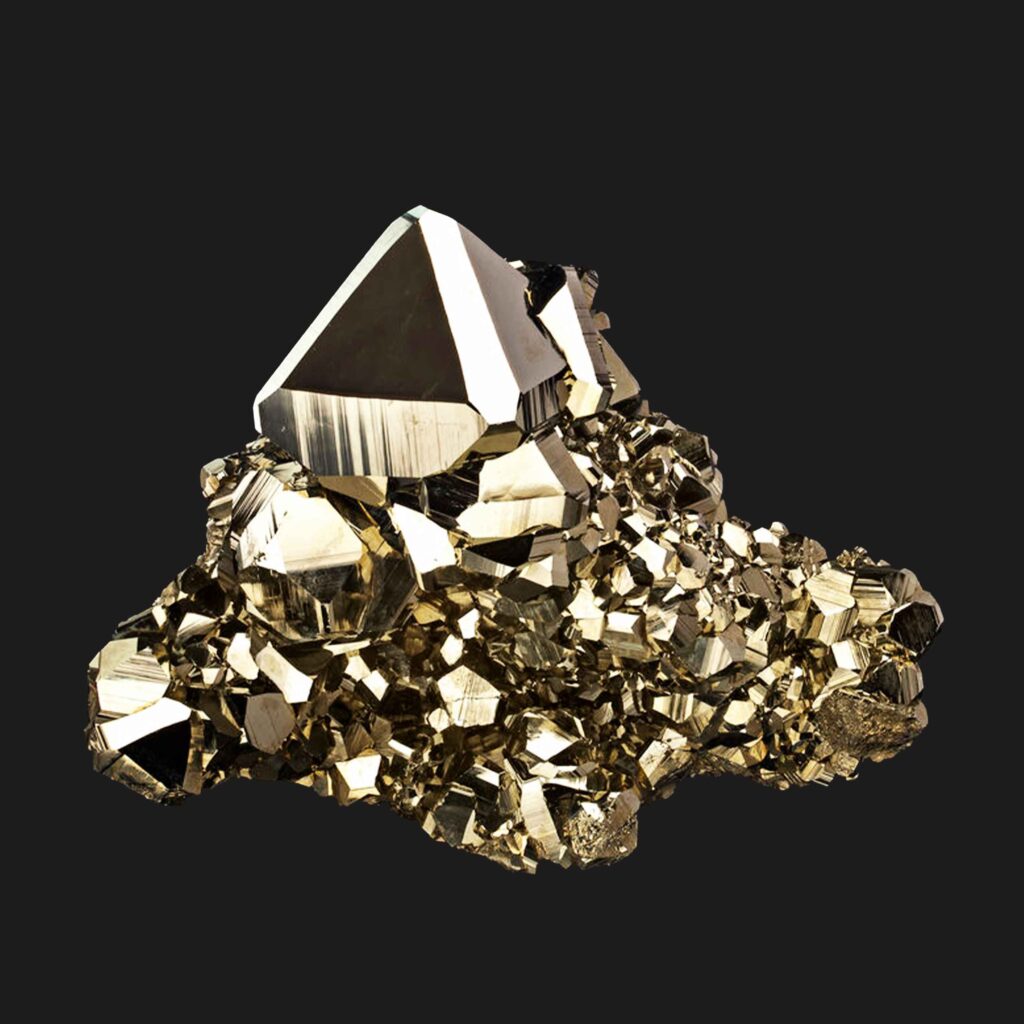
What makes this specimen investment grade:
● Hyper-perfect condition
● Extremely well crystalized
● ”Rockstar” – published in multiple media sources
● Example is an ”11” !
● Arguably best of species
Representative localities:
● Huanzala, Peru
● Navajun, Spain
● Washington State, USA
● Butte, Montana, USA
”This mineral made the miners crazy!”
When dioptase was discovered in the Tsumeb mine, this mineral’s sheer beauty, quality, and abundance generated quite the stir in mineral collecting circles. The gemmy emerald green of the dioptase situated on top of rhombic white calcite is, to this day, one of the most beautiful combinations in the mineral world. When I was a child, I corresponded with the mine manager at Tsumeb, and he sent me a small dioptase specimen. When the parcel arrived, and I held the dioptase in my hands, it was love at first sight. Countless collectors owe their beginnings to Tsumeb dioptase. This particular example is so aesthetic, architectural, and otherwordly that words do not describe its innate presence. So, please, just look at the picture!
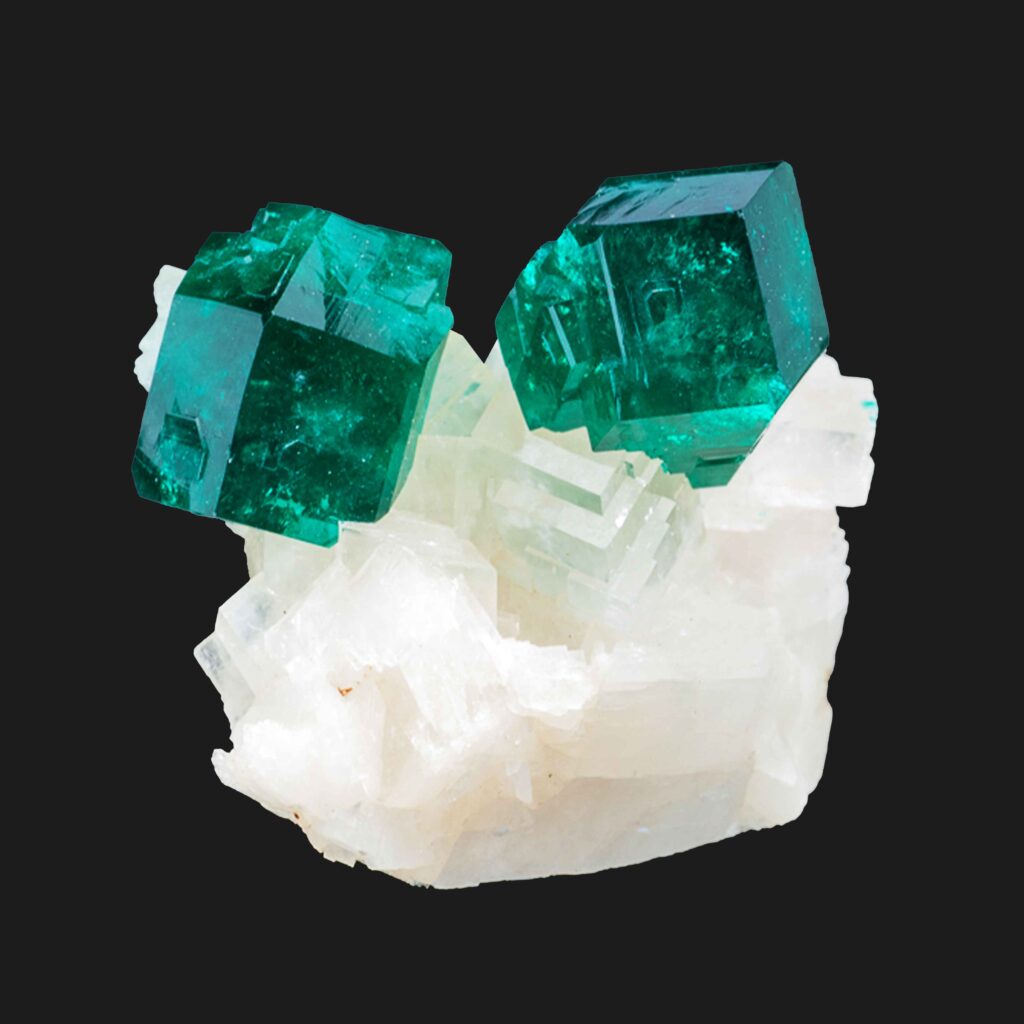
What makes this specimen investment grade:
● Aesthetic arrangement is superb
● Vivid coloration and contrast
● Tsumeb #1 collectible mineral locality
● ”Rockstar” – published in multiple media sources
Representative localities:
● Tiger, Arizona, USA
● Kaokoveld, Namibia
● Altyn-Tube, Russia
(Classic locality)
Smithsonite is named after James Smithson, the founder of the Smithsonian Institution in Washington, D.C.
Undulating crystalline masses of the most intense vibrant blue-green smithsonite from the classic locality of Tsumeb, Namibia. This is a prime example of a botryoidal mineral, literally greek for ”bunch of grapes”, discovered over a hundred years ago in the finest mineral repository on earth, Tsumeb. This mine is famous for gemmy crystallized smithsonite in many different color variations, but this specimen is considered the finest botryoidal smithsonite the mine has produced. Cave-like structure, blue-green color, and intense ”sparkle” reminiscent of a 4th of July fireworks display make this mineral specimen truly mesmerizing.
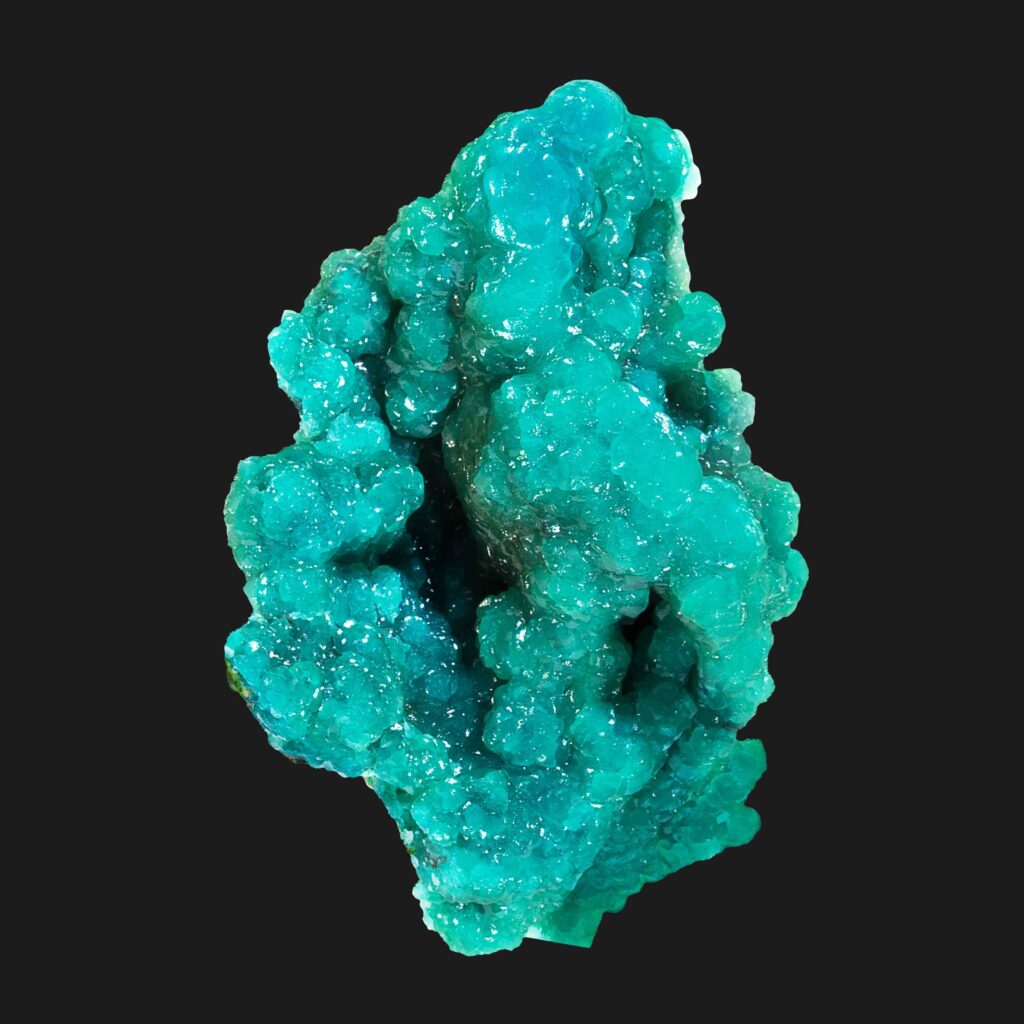
What makes this specimen investment grade:
● Vivid blue-green coloration – ”eye-candy”
● Shimmering botryoidal form
● Finest botryoidal smithsonite found at Tsumeb
● Superb provenance
Representative localities:
● Kelly Mine, New Mexico, USA
● Berg Aukas, Namibia
● Broken Hill, Zambia
● Sardinia, Italy
Although garnets are usually associated with the color red, it would come as a surprise to most that garnets occur in many other colors: green, yellow, orange, pink, mint, and purple. The example pictured here, a demantoid garnet from Madagascar, is of fairly recent vintage (the locality was only discovered in 2009). The greatness of this specimen hinges upon the gem forest-green multifaceted garnet crystal on a contrasting white textural matrix. The piece has the look of a lapidary object that would not look out of place at Van Cleef and Arpels… When looking for a superior garnet specimen, the following criteria are critical: clarity, color, and complex crystal form. Garnets are fairly common, so keeping the quality level as high as possible on all these attributes is integral. In the gem world, tsavorite and demantoid garnets are extremely valuable when the quality level is at the top of the hierarchy, thus the mineral specimens can be an equally important investment.
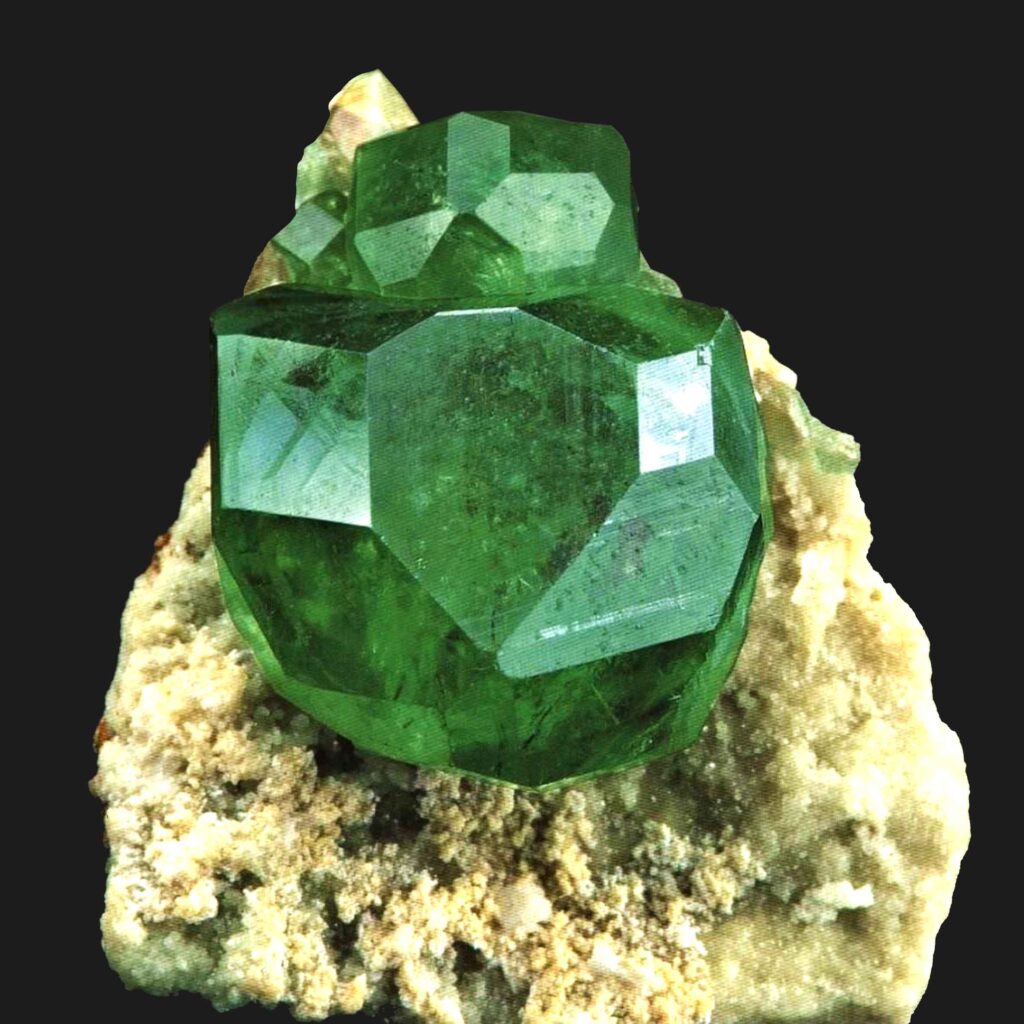
What makes this specimen investment grade:
● Rare species of garnet
● Crystal morphology and gemminess are superb
● Contrast between garnet and matrix is excellent
● ”Rockstar” – published in multiple media sources (Cover piece)
Representative localities:
● Wrangell, Alaska, USA
● Ramona, California, USA
● Minas Gerais, Brazil
● Asbestos, Quebec, Canada
Tanzanite, the baby-boomer gemstone…
In the late 1960s, a beautiful purple-blue crystal was brought to the offices of Tiffany & Co, and the beautiful gem, tanzanite, was born…
Known for its remarkably strong trichoism, appearing alternately blue, violet, and burgundy depending on the crystal orientation. Tanzanite’s only known deposit of commercial importance is in northern Tanzania, near the base of Mount Kilimanjaro. This specimen is desirable due to the two quartz crystals on the right side contrasting clear-white to the vivid blue of the tanzanite crystal. Tanzanite is a gem commodity; acquiring a crystal with the utmost gem value is critical to investing; hence clarity and color are paramount. The majority of tanzanite comes out of the mine as single crystals; thus, having an association increases the value and desirability considerably.
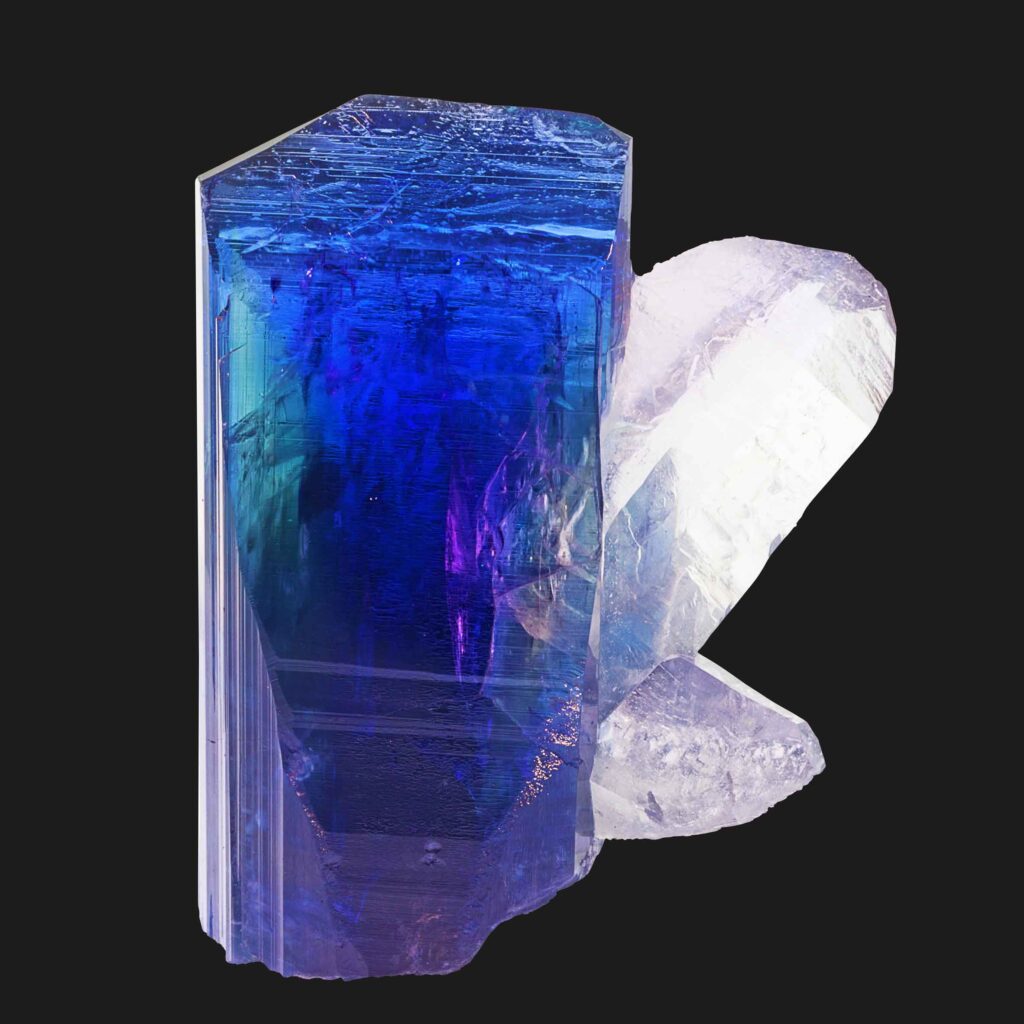
What makes this specimen investment grade:
● Quartz association
● Excellent contrast (quartz/tanzanite)
● Gem value
● Single locality
Representative localities:
● Single locality – (Only found in Tanzania)
connoisseur, con·nois·seur, def. : one who understands the details, technique, or principles of an art and is competent to act as a critical judge
Connoisseur Minerals: Investment-grade minerals are so rare that acquiring them will take effort, education, and access. The connoisseur studies thousands of specimens, visits numerous institutions, and associates with as many experts in the field as they can. Connoisseurship is a life-long endeavor with substantial intellectual, social, and potentially financial rewards. The following five are connoisseur-level minerals.
cumengeite – ”the star of a connoisseur’s mineral collection”
Cumengeite is the ”star” of the mineral kingdom… The distinctive star formation of cumengeite makes the species unique and highly desirable. The finest cumengeite crystals were discovered in the Amelia Mine in the late 19th century. The cobalt blue crystals can reach over an inch in size but the majority of the rare crystals are less than 1/4 inch. The monster crystals from the Amelia mine reside in the natural history museums of Paris. In the 1970s the was a renewed effort to mine the elusive crystals with little success. The rarity, beauty, structure, and color make cumengeite a true connoisseur mineral; hence, an excellent investment. Lucky is the collector that acquires a decent-sized cumengeite with good quality, that’s how unobtainable they are. Rarity plus beauty equals desirability…
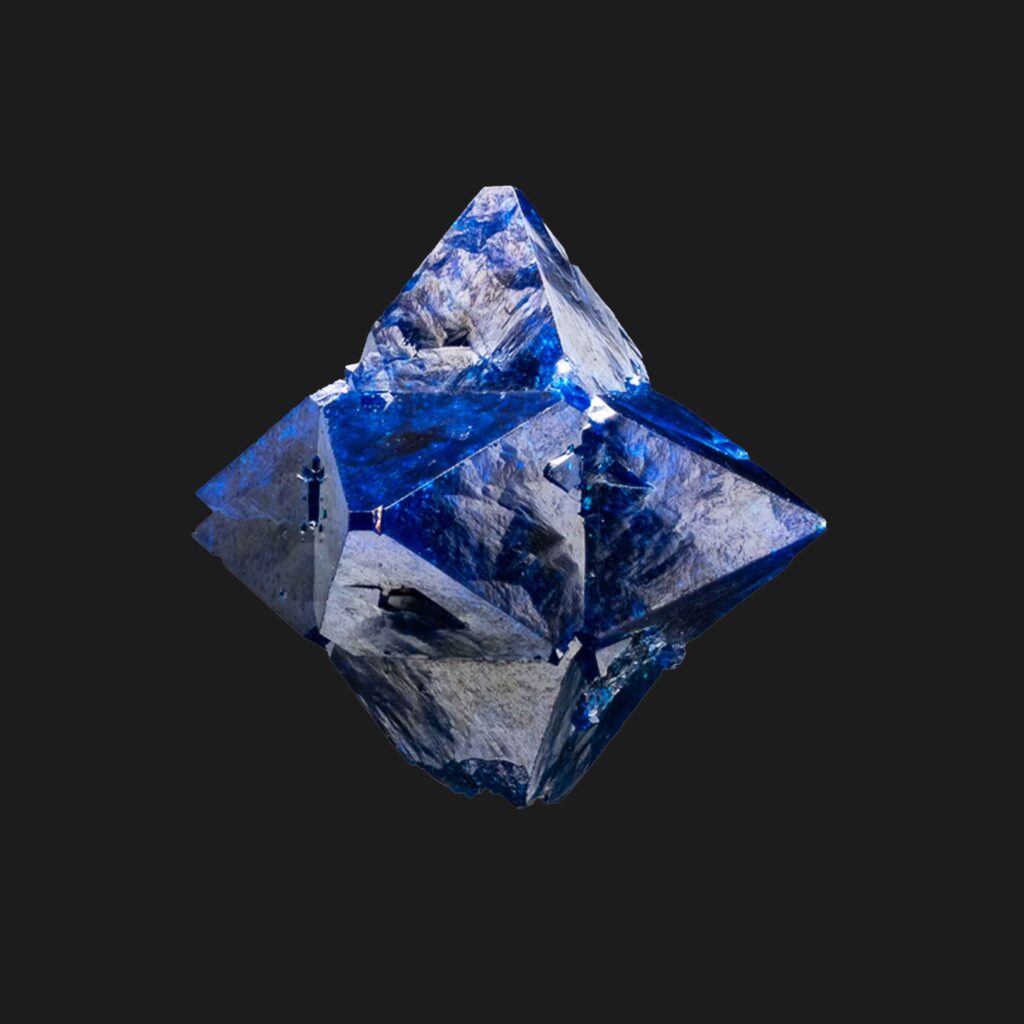
What makes this specimen investment grade:
● Beautiful architectural crystal structure
● Cobalt blue color
● Classic, but exhausted locality
Representative localities:
● Basically, one locality wonder
You know you have a popular yet rare mineral when it is also used as an anime character in Japanese pop culture…
Phosphophyllite is so rare and beautiful that words are hard to describe the unique nature of the species. Phosphophyllite is one of the ”holy grail” minerals, any advanced collector/connoisseur desires to have in their collection. The qualities of phosphophyllite are so ethereal; the color has to be seen to be appreciated; a glowing teal, gem-like, multifaceted, and transparent to the point of unreality. All the phosphophyllites ever found would fit on a small portion of a traditional dining room table; that includes cleaved and broken crystals!
This matrix specimen, a rarity in itself, combines the classic color of phosphophyllite, transparency to the point you can see the matrix through the crystal, and excellent condition for such a soft mineral. Smaller gem crystals surround the larger untwinned phosphophyllite to complete this masterpiece.
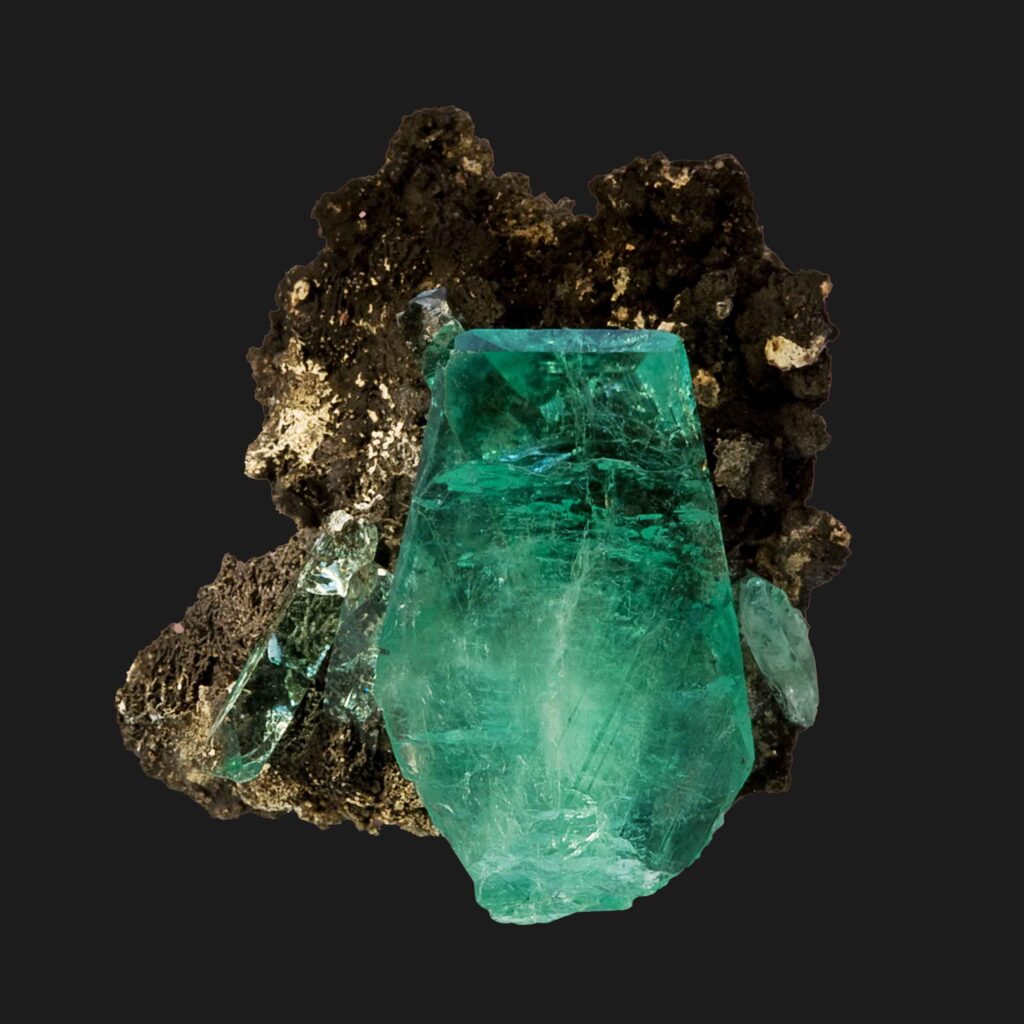
What makes this specimen investment grade:
● Extremely rare species
● Unique color in the mineral kingdom
● Matrix specimen/good color contrast
● Uncommon, untwinned crystal
Representative localities:
● Unificada mine, Bolivia
(majority of gem crystals)
● Bavaria, Germany
(classic locality)
The rarest form of beryl is found in only one region, Beaver County, Utah. Red Beryl is so rare that the Utah Geological Survey estimated that one crystal of red beryl is found for every 150,000 gem-quality diamonds. Of the few red beryl crystals mined, perhaps 5% can potentially cut a gemstone!
The specimen pictured here has been named ”The Kissing Beryls” for obvious reasons. The upper-third of the two crystals are gem-quality and of the best color. The contrasting white rhyolite coupled with the fabulous aesthetic makes this specimen one of the finest red beryls ever discovered. Connoisseur mineral + rarity + beauty makes for an excellent investment quality mineral.
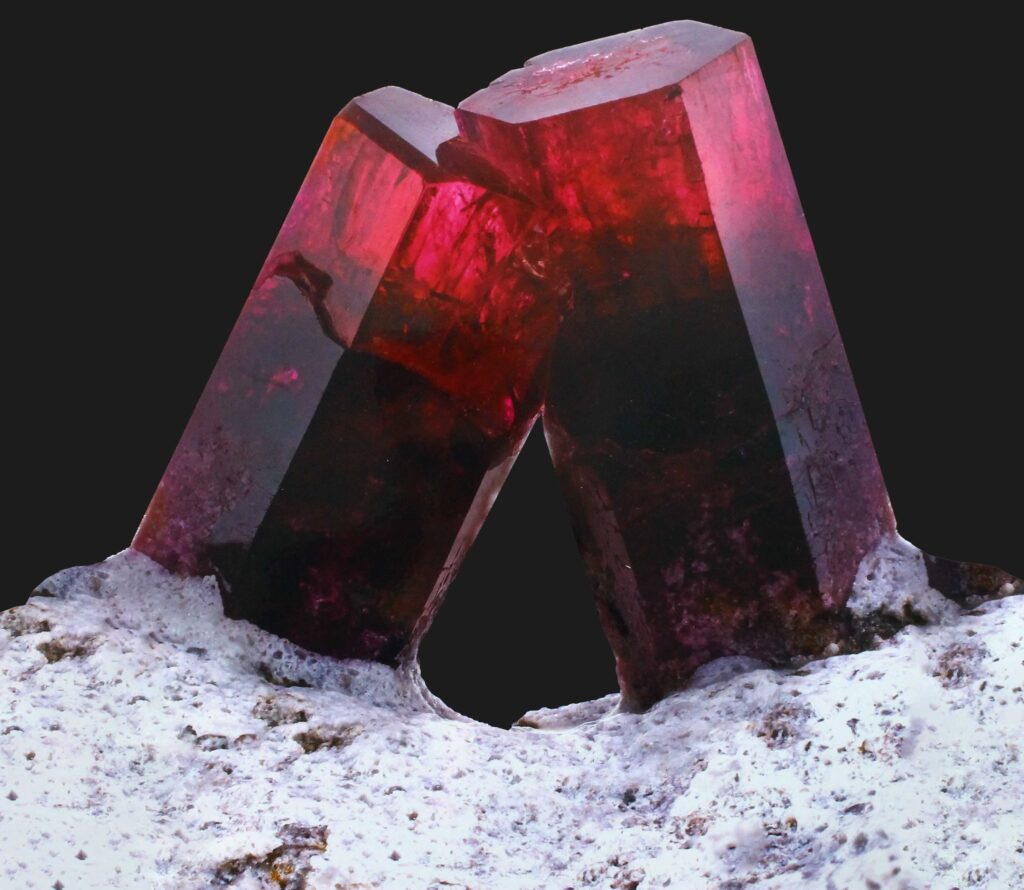
What makes this specimen investment grade:
● Extreme rarity and desirability
● Superb aesthetics ” Kissing beryls”
● Excellent contrast: red crystals on white matrix
● Gem value
Representative localities:
● One locality wonder
The color of liroconite makes even the most jaded mineral connoisseur’s heart beat faster and break out in the ”vapors” as the English like to say. Entirely appropriate as liroconite is found in Cornwall, England. Condition, color, and crystal size are paramount to the collectability of this rare species. Liroconite in large crystals, which are bigger than one centimeter, is extremely rare. As an investment vehicle, all these aspects are critical to the evaluation of a truly great liroconite.
This liroconite from the Royal Cornwall Museum in Truro, U.K., is a monster! The crystal size is extraordinary, by far the highest quality and largest in existence. The matrix is both botryoidal and contrasting in color to the azure blue of the liroconite. One of the top 25 mineral specimens in existence. Discover one of these and retire early…
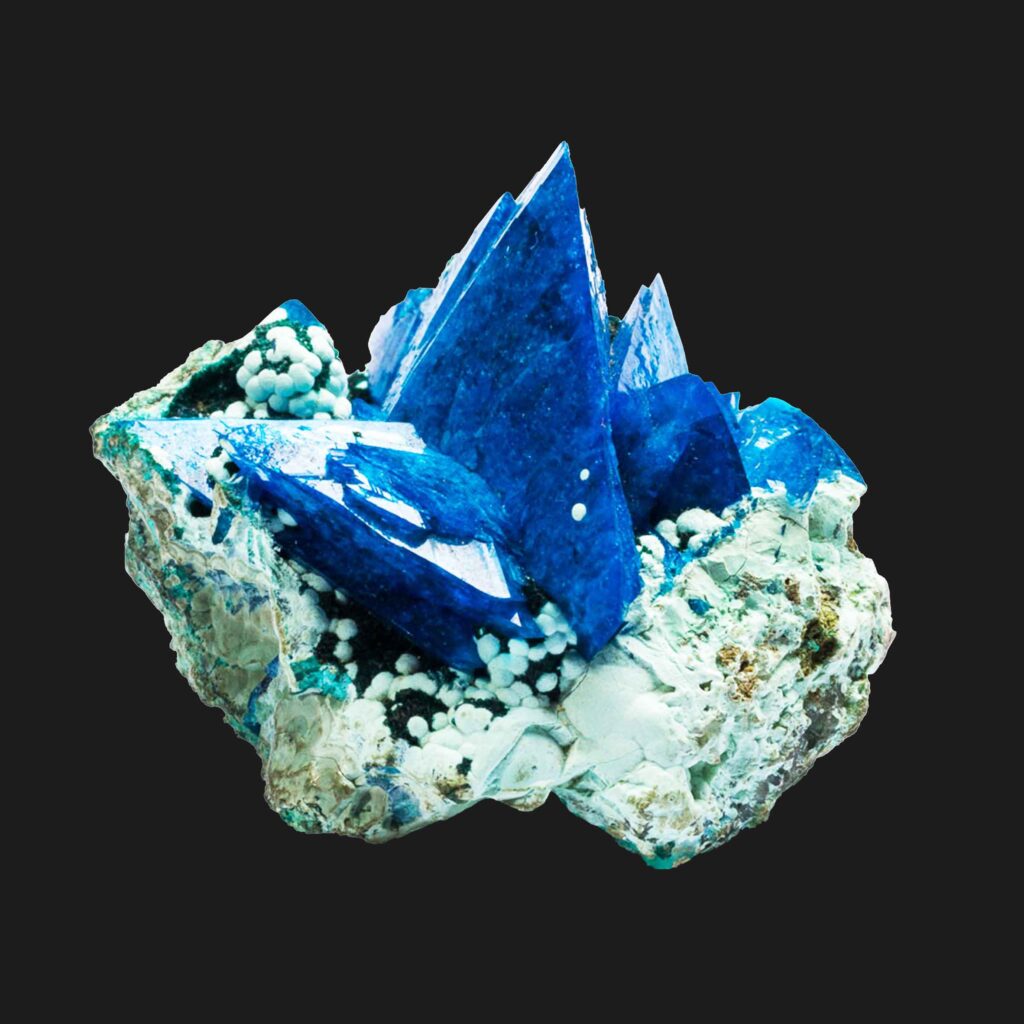
What makes this specimen investment grade:
● ”Wow factor” – most connoisseurs know the ”Truro” liroconite
● Best of species by order of magnitude
● Extremely rare
● Excellent condition
Representative localities:
● Found in collectible crystals in one locality
When astronauts from the space station look down upon the Earth, the color is reminiscent of the finest euclase. In some specimens, the color is unique in nature, rivaling the best deep blue of the Indian Ocean. Euclase is rare when the color is supreme, the crystal form is multifaceted, and the condition is perfect. Most euclase appears on the market as single crystals; thus, matrix specimens are highly desired. The fact that euclase is a gem commodity enhances its value and desirability.
This specimen is an architectural wonder… The euclase crystals intersect with the white crystalline matrix at a 90-degree angle, along with a triad of quartz crystals emanating from the black shale. This wonderful euclase specimen originates from Boyacá, Colombia, not far from the famous emerald district. This superb mineral specimen’s aesthetics and visual impact make for a lasting memory in the souls of advanced collectors.
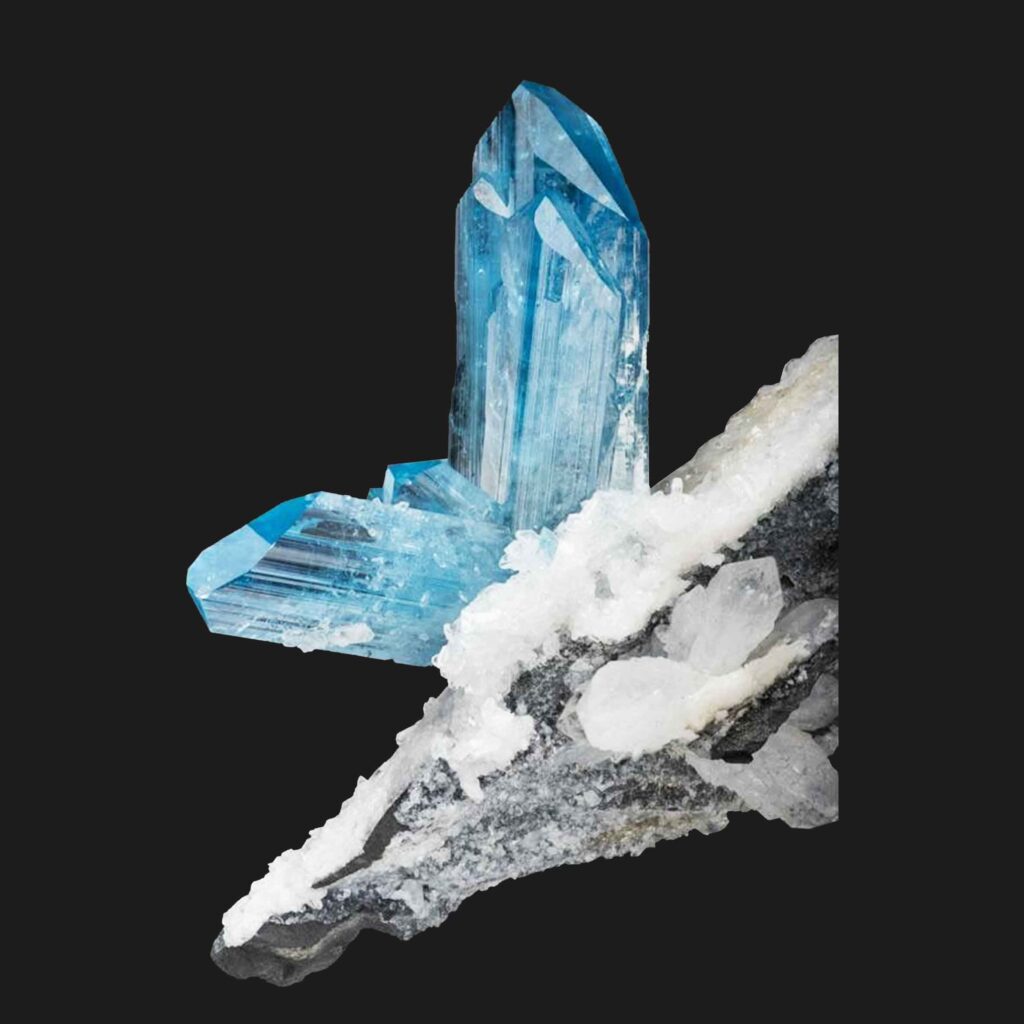
What makes this specimen investment grade:
● Sheer beauty of the crystal arrangement
● Color contrast – sky blue with white
● ”Wow factor”: rare + beauty
● Condition, color, and luster superb
Representative localities:
● Tyrol, Austria
● Ouro Preto, Brazil
● Boyaca, Colombia
“If you plan to collect minerals, do your research. Go to galleries, museums, and gem shows to discover what’s in demand and what resonates with you. When you’re ready to buy, find an experienced dealer to help you and to make sure your mineral has the attributes that will allow it to appreciate. And bring money: prices for collectible minerals, which typically start above $1,000, can go as high as $5 million.”
-Margie Goldsmith, Business Jet Traveler-
Copyright @GreatRocksInc 2022